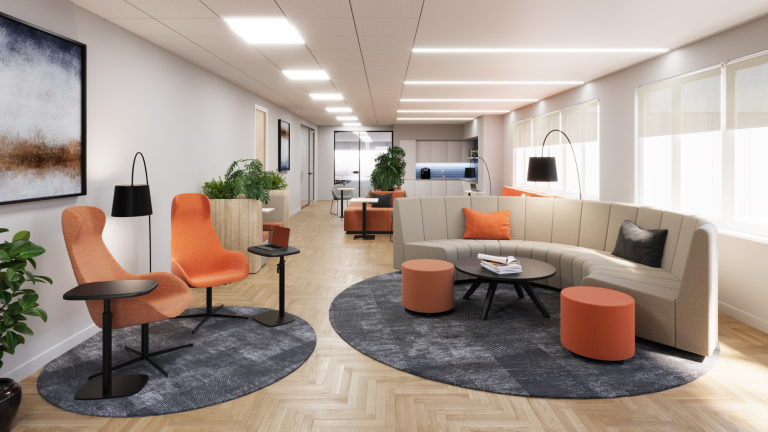The future of commercial interior design is being shaped by the evolving demands of hybrid work, technology, and the ever-increasing focus on employee well-being. As businesses adjust to new working models, the office environment is being reimagined to foster collaboration, socialisation, and connection. The traditional rigid office layouts are being replaced with dynamic spaces designed to meet the needs of modern workers. In 2025, commercial interior design is all about creating workplaces that not only function but enhance the overall employee experience. So, how are these factors influencing commercial seating design?
Reconfiguration for Collaboration and Socialisation
One of the standout trends for 2025 is the continued shift towards reconfiguring office layouts to accommodate collaboration and socialisation. With research from the CIPD showing that most employees are expected in the office for two (35%) or three (33%) days per week, organisations are placing a strong emphasis on creating environments that encourage in-person connections. The same research highlights that employees feel they collaborate better in person (55%), build stronger relationships (57%), and are more engaged (47%) when working from the office.
This trend goes beyond traditional hot-desking setups, focusing instead on spaces where casual interactions can happen naturally. Companies are designing workspaces that allow employees to easily connect, share ideas, and work together in dynamic environments. This approach to office design acknowledges that while hybrid working is here to stay, the need for human connection and collaboration remains critical.
Flexible and Adaptable Furniture Choices
In 2025, offices are evolving from static environments to adaptable ecosystems. Modular furniture and multi-purpose spaces are leading the way. Offices are no longer designed as fixed spaces but are becoming more flexible, with furniture that can be quickly reconfigured to meet changing needs. This shift allows teams to easily adjust their environment for brainstorming sessions, group meetings, or private discussions as required.
Flexible furniture solutions such as modular seating help create environments that support face-to-face collaboration. The integration of casual lounges and social zones also encourages employees to step away from their desks, engage in informal conversations, and spark creativity. These spaces promote community-building, providing areas where employees can relax, collaborate, and foster a sense of belonging. The goal is to create workplaces that are human-centric—spaces that people are excited to spend time in, not just to work but to engage with colleagues.
Appeal to the Senses
2025 office designs are also set to prioritise sensory experiences. Offices will feature colours, textures, and organic shapes to create inviting environments that feel warm and welcoming. Moving away from sharp lines, softer, rounded edges will encourage people to gather in communal spaces. Combining irregular shapes with organic forms, as well as introducing asymmetry and symmetry, adds balance and flow to the design.
The rise of maximalism, with bold patterns and vibrant hues, will contrast beautifully with the organic design trend that draws inspiration from nature. Accents such as fluting, scalloped edges, and textural details will tie together various elements in a cohesive way. Mixing contrasting colours and textures will add depth to the design, making the workspace feel dynamic yet comfortable, reflecting the diversity of the employees who work there.
Update, Refresh, and Revitalise
As businesses become more conscious of sustainability, the focus is shifting towards updating and refreshing existing office furniture rather than replacing it entirely. Companies are increasingly turning to eco-friendly materials and re-upholstery solutions to extend the life of their furniture. This trend is not only more sustainable but also cost-effective, as businesses seek ways to reduce waste while maintaining a modern and functional office environment.
Re-upholstery is gaining popularity in sectors with heavy foot traffic, such as cinemas, hospitals, and commercial spaces, where durable and sustainable design is a priority. Employers are also recognising that small touches, like adding greenery, feature lighting, and utilising natural light, can significantly enhance the workplace atmosphere and boost employee morale.
Prioritising the Experience
In 2025, the focus of commercial design will be on the overall employee experience. Research shows that younger and junior employees particularly benefit from in-person interactions, and companies are prioritising the design of spaces that encourage spontaneous conversations and mentorship opportunities.
Businesses are making better use of their office spaces by creating areas that can serve multiple functions throughout the day. Open-plan lounges, banquette seating, and booths can transition from hosting small meetings to providing casual spaces for networking or coffee breaks. This approach ensures that offices remain engaging, fostering connections and encouraging collaboration between employees.
This focus on experience is also extending into the hospitality sector, where socialisation is key to the success of customer interactions.
